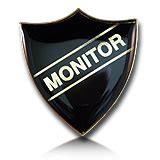Introduction

Hall monitor badges are a symbol of responsibility and authority, empowering students to play an active role in maintaining order and creating a positive learning environment. These badges represent a partnership between students and educators, fostering a sense of community and shared ownership of the school.
Benefits of Hall Monitor Badges
Numerous studies have demonstrated the positive impact of hall monitor programs on school climate and student behavior. Key benefits include:
- Reduced Disciplinary Incidents: Students serving as hall monitors are less likely to engage in disruptive behavior, as they understand the importance of maintaining order.
- Enhanced School Safety: Hall monitors assist in ensuring the safety and well-being of students by monitoring hallways, reporting suspicious activity, and assisting with emergency procedures.
- Improved Communication and Relationships: Hall monitors serve as a bridge between students and staff, fostering open communication and promoting positive relationships.
- Increased Student Ownership: By empowering students to take ownership of their school environment, hall monitor programs foster a sense of responsibility and pride.
Motivations for Students to Become Hall Monitors
Students are motivated to become hall monitors for a variety of reasons, including:
- Desire to Contribute to Their School: Hall monitors want to make a meaningful difference in their school community.
- Opportunity for Leadership and Responsibility: This role allows students to demonstrate their leadership skills and take on additional responsibilities.
- Recognition and Reward: Many schools reward hall monitors with special recognition, privileges, or incentives.
- Personal Growth and Development: Serving as a hall monitor provides students with valuable experience in communication, problem-solving, and conflict resolution.
Pain Points and Common Mistakes to Avoid
While hall monitor programs can be highly effective, there are potential pain points and common mistakes to avoid:
Pain Points:
- Insufficient Training and Support: Hall monitors may not receive adequate training or support, which can lead to confusion and ineffective monitoring.
- Lack of Clear Expectations: Students may not fully understand their roles and responsibilities as hall monitors.
- Insufficient Recognition and Accountability: Hall monitors may feel undervalued or unappreciated, which can undermine their commitment to the program.
Common Mistakes:
- Overpowering Hall Monitors: Schools should avoid giving hall monitors excessive authority or responsibility.
- Unclear Communication of Expectations: Failing to clearly define the roles and responsibilities of hall monitors can lead to confusion and ineffective monitoring.
- Ineffective Conflict Resolution: Hall monitors may encounter challenging situations that require effective conflict resolution skills, which they may not possess.
Selecting and Training Hall Monitors
Carefully selecting and training hall monitors is crucial for the success of the program. Consider the following criteria:
- Responsible and Mature: Ideal candidates exhibit responsible behavior, self-control, and maturity.
- Good Communication Skills: Hall monitors should be able to communicate effectively with both students and staff.
- Interested in Leadership: Students should demonstrate a desire to contribute to their school community and take on leadership roles.
- Training: Hall monitors should receive comprehensive training on their roles, responsibilities, conflict resolution techniques, and school policies.
Metrics for Measuring Success
To evaluate the effectiveness of a hall monitor program, consider tracking the following metrics:
- Disciplinary Referrals: Compare the number of disciplinary referrals before and after implementing the program.
- Student Surveys: Conduct surveys to gauge student perceptions of school climate and safety.
- Teacher Observations: Collect teacher feedback on the behavior and effectiveness of hall monitors.
Innovative Applications of Hall Monitor Badges
Beyond traditional monitoring duties, hall monitor badges can be used in innovative ways to enhance the school environment. Consider the following applications:
Table 1: Alternative Uses of Hall Monitor Badges
| Application | Description | Example |
|---|---|---|
| Peer Mentors | Hall monitors provide guidance and support to new or struggling students. | Mentoring students with special needs or English language learners. |
| Environmental Stewards | Hall monitors promote environmental awareness and sustainability. | Monitoring recycling bins and encouraging energy conservation. |
| Safety Patrols | Hall monitors assist with traffic control, pedestrian safety, and emergency preparedness. | Directing traffic at school events or monitoring bus safety. |
Hall Monitor Badges: Enhancing School Climate and Empowering Students
Hall monitor badges represent a valuable tool for empowering students, fostering a positive school climate, and promoting safety. By carefully selecting, training, and supporting hall monitors, schools can reap the numerous benefits of this effective program. Innovation and creativity in using hall monitor badges can further enhance their impact, creating a more welcoming, supportive, and successful learning environment.
